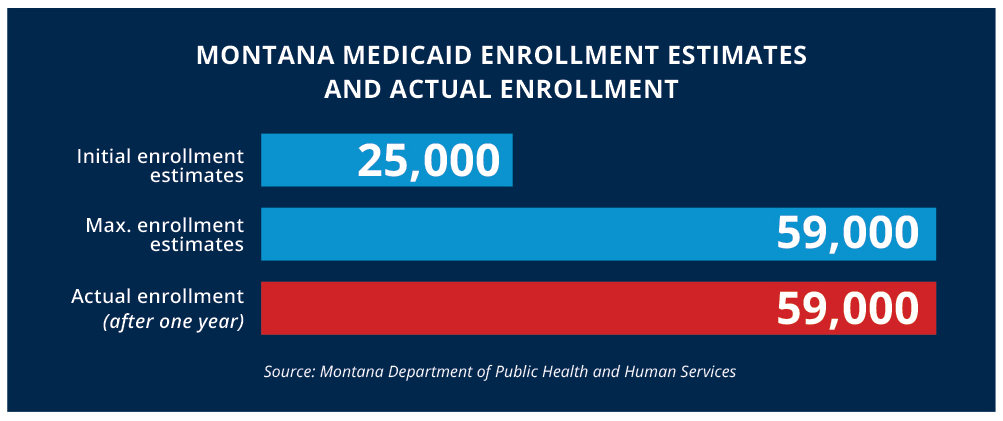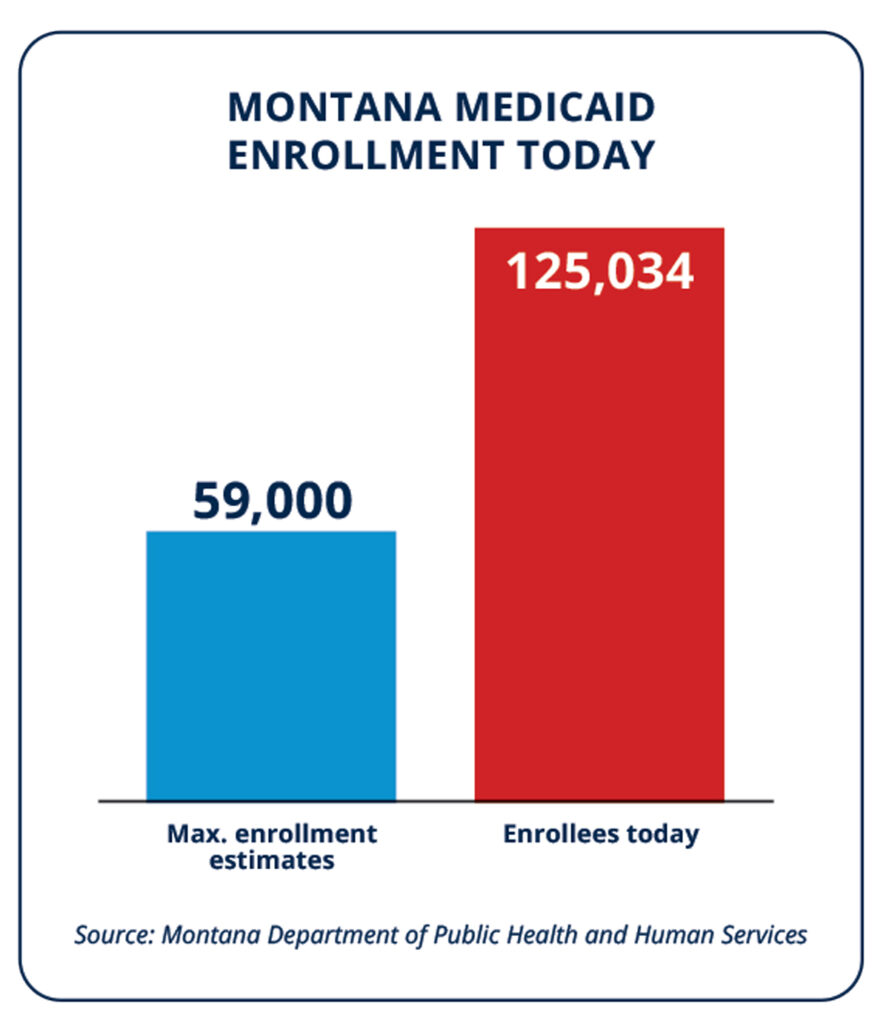Medicaid Expansion Has Been a Disaster for Montana, But Lawmakers Can Reverse Course
KEY FINDINGS
- Montana expanded Medicaid to a new class of able-bodied adults in 2016 and reauthorized the program in 2019.
- Expansion enrollment in Montana has gone haywire, as more able-bodied adults have enrolled than “experts” ever thought possible.
- As enrollment overruns have ravaged the state, Medicaid spending has soared, crowding out other budget priorities.
- Despite false promises, Medicaid expansion has failed to save Montana hospitals.
- Montana lawmakers are in a unique position to turn the tide and should refuse to reauthorize the Medicaid expansion program.
Overview
Under the Affordable Care Act, commonly known as ObamaCare, states have the option to expand their Medicaid programs to an entirely new class of able-bodied adults.1 Like many other states, Montana bought into the lies and deception of Medicaid expansion, expanding its Medicaid program in 2016.2
In 2019, Montanans voiced their concerns with the program but were ultimately overridden by then-Governor Steve Bullock, who reauthorized Medicaid expansion for an additional six years.3 The results that followed were devastating for Montanans. Medicaid enrollment has skyrocketed, spending has soared, other budget priorities are on the back burner, and the truly needy have been left behind.4

While Montana’s disastrous experience with Medicaid expansion is not unique, state lawmakers are uniquely positioned to reverse course and scrap the program altogether. To do so, Montana lawmakers should refuse to reauthorize the Medicaid expansion program.
Able-bodied adults have flooded the Medicaid rolls
Prior to expansion, there was intense debate throughout Montana about whether expansion was the correct decision. Advocates argued that only 25,000 residents would initially be eligible and that 59,000 able-bodied adults would represent maximum enrollment.5-6 Unsurprisingly, actual expansion enrollment shattered these estimates.

Just one year into Medicaid expansion, there were already 59,000 Montanans enrolled in the program—136 percent more than initial projections.7 And only one year into expansion, Montana had already achieved the “maximum enrollment” projected by expansion proponents.8 Unfortunately, the nightmare was just beginning.
Today, there are more than 125,000 able-bodied adults enrolled in expansion in Montana—more than double what enrollment advocates ever thought possible.9 Able-bodied adults enrolled in expansion represent 39 percent of total Medicaid enrollment throughout the state—nearly four of every 10 enrollees.10 These able-bodied adults also account for 11 percent of Montana’s total state population.11 Even worse, there are more able-bodied adults on Medicaid in Montana than there are children enrolled in traditional Medicaid.12

While these enrollment figures might seem extraordinary, the writing was on the wall. On average, expansion states have experienced enrollment overruns of 186 percent—nearly triple what advocates predicted.13
Unfortunately for Montana, these enrollment hikes have led to increased spending that is crowding out other budget priorities.
Medicaid spending has soared, crowding out other priorities
In 2000, Medicaid spending accounted for 15.9 percent of all budgetary expenditures in Montana.14 By 2015—the year before expansion was implemented—Medicaid spending had grown by less than two percent.15 Unfortunately, the same cannot be said about the years that followed.
In 2022—six years into Montana’s expansion—Medicaid spending accounted for more than one in every four dollars spent in the state.16 To put this into perspective, Medicaid spending grew six times faster in the six years following expansion than it had in the decade and a half prior to expansion.17 As Medicaid spending surged, other budgetary priorities suffered.
Indeed, K-12 education accounted for nearly 21 percent of all spending in 2000.18 But by 2022, K-12 spending had declined to 15.3 percent—a decrease of 26 percent.19 Spending on higher education, as well as transportation, has declined over this time.20
Despite what expansion advocates may claim, this crowd-out effect can be directly attributed to increased Medicaid spending after expansion went into effect. For example, in 2015, total Montana Medicaid spending was $1.1 billion.21 But by 2022, Medicaid spending had skyrocketed to $2.3 billion—more than doubling in seven years.22 In fact, spending had outpaced projections by 70 percent just two years into the program.23

Medicaid expansion has failed to save hospitals
Advocates of expansion often claim that by expanding Medicaid, states can tackle the problem of uninsured residents and alleviate the burden of uncompensated care costs on hospitals.24 However, these promises have failed to materialize in Montana.25 Prior to expansion, the uninsured rate in Montana was steadily declining.26 In fact, the three years before expansion saw sharper decreases in the uninsured rate than the three years following expansion.27
Once Medicaid expansion was implemented, the number of Montanans enrolled in the program dramatically spiked. But rather than reducing the number of uninsured Montanans—which was already declining—expansion shifted people from private insurance to Medicaid.28 As thousands of Montanans were moved from private insurance to Medicaid, taxpayers and providers were left footing the bill.

Medicaid reimburses hospitals and providers at a much lower rate compared to private insurance—and often below the cost of care itself.29 As an increased number of able-bodied adults were enrolled in the Medicaid program, hospitals and providers saw their reimbursements plummet.30 Montana’s hospitals saw a collective 40 percent decline in their profit margin during the first full year of Medicaid expansion.31 The head of the Montana Hospital Association pointed to “cost shifting” as the culprit due to an increased number of Medicaid reimbursements falling below the cost of care.32
The Montana Hospital Association’s internal data confirms that the sharp decline in profits was the result of massive shifts in the payer mix from private insurance to Medicaid.33 From 2016 to 2017, Medicaid’s share of total patient charges grew by 20 percent, while the portion attributable to “self-pay” plummeted by nearly 30 percent.34
Unsurprisingly, as more Montanans were shifted from private insurance to Medicaid, the reimbursement rates for hospitals dramatically declined. This, combined with massive enrollment overruns and out-of-control spending, is a recipe for disaster. Thankfully, lawmakers have a solution at their disposal.
The Bottom Line: Montana lawmakers must reject Medicaid expansion once and for all.
Montana lawmakers are in a unique situation. They get to decide, much like in 2019, whether or not to reauthorize Medicaid expansion. Fortunately, evidence from the past eight years should make the decision easier. Medicaid enrollment has shattered projections, with able-bodied adults flooding the Medicaid rolls at a higher rate than ever thought possible. Spending on the Medicaid program has more than doubled since 2015—the year before expansion was implemented. And the promises of improved and more robust hospitals have failed to materialize.
Put simply, Medicaid expansion has been a disaster for Montana. To rectify this situation once and for all, Montana lawmakers must not reauthorize the Medicaid expansion program.

References
1 Jonathan Bain, “Busted budgets and skyrocketing enrollment: Why states should reject the false promises of Medicaid expansion,” Foundation for Government Accountability (2023), https://thefga.org/research/states-should-reject-false-promises-of-medicaid-expansion.
2 Hayden Dublois, “Medicaid expansion has been a disaster for Montana,” Foundation for Government Accountability (2020), https://thefga.org/research/montana-medicaid-expansion.
3 Ibid.
4 Ibid.
5 Kaiser Health News, “Montana Medicaid expansion by-the-numbers,” Kaiser Family Foundation (2016), https://kffhealthnews.org/news/montana-medicaid-expansion-by-the-numbers.
6 Montana Budget and Policy Center, “Medicaid Expansion: A good deal for Montana,” Montana Budget and Policy Center (2012), https://www.mbadmin.jaunt.cloud/wp-content/uploads/2013/08/Medicaid-Expansion-Is-a-Good-Deal-forMontana_0.pdf.
7 Hayden Dublois, “Medicaid expansion has been a disaster for Montana,” Foundation for Government Accountability (2020), https://thefga.org/research/montana-medicaid-expansion.
8 Ibid.
9 Montana Department of Health and Human Services, “Montana Medicaid enrollment dashboard,” Montana Department of Health and Human Services (2023), https://dphhs.mt.gov/interactivedashboards/medicaidenrollmentdashboard.
10 Author’s calculations based on the number of Medicaid expansion adults as a percentage of total Medicaid enrollees in Montana.
11 Author’s calculations based on the number of Medicaid expansion adults as a percentage of total population in Montana, as estimated by the Census Bureau.
12 Author’s calculations based on the number of Medicaid expansion adults compared to the number of children enrolled in traditional Medicaid.
13 Jonathan Bain, “Busted budgets and skyrocketing enrollment: Why states should reject the false promises of Medicaid expansion,” Foundation for Government Accountability (2023), https://thefga.org/research/states-should-reject-false-promises-of-medicaid-expansion.
14 Hayden Dublois, “Medicaid expansion has been a disaster for Montana,” Foundation for Government Accountability (2020), https://thefga.org/research/montana-medicaid-expansion.
15 Ibid.
16 Brian Sigritz et al., “2022 state expenditure report,” National Association of State Budget Officers (2022), https://higherlogicdownload.s3.amazonaws.com/NASBO/9d2d2db1-c943-4f1b-b750-0fca152d64c2/UploadedImages/SER%20Archive/2022_State_Expenditure_Report_-_S.pdf.
17 Author’s calculations based on Montana’s Medicaid spending as reported in the 2000 and 2022 National Association of State Budget Officers expenditure reports.
18 Hayden Dublois, “Medicaid expansion has been a disaster for Montana,” Foundation for Government Accountability (2020), https://thefga.org/research/montana-medicaid-expansion.
19 Brian Sigritz et al., “2022 state expenditure report,” National Association of State Budget Officers (2022), https://higherlogicdownload.s3.amazonaws.com/NASBO/9d2d2db1-c943-4f1b-b750-0fca152d64c2/UploadedImages/SER%20Archive/2022_State_Expenditure_Report_-_S.pdf.
20 Hayden Dublois, “Medicaid expansion has been a disaster for Montana,” Foundation for Government Accountability (2020), https://thefga.org/research/montana-medicaid-expansion.
21 Ibid.
22 Brian Sigritz et al., “2022 state expenditure report,” National Association of State Budget Officers (2022), https://higherlogicdownload.s3.amazonaws.com/NASBO/9d2d2db1-c943-4f1b-b750-0fca152d64c2/UploadedImages/SER%20Archive/2022_State_Expenditure_Report_-_S.pdf.
23 Hayden Dublois, “Medicaid expansion has been a disaster for Montana,” Foundation for Government Accountability (2020), https://thefga.org/research/montana-medicaid-expansion.
24 Hayden Dublois, “Medicaid expansion is closing hospitals,” Foundation for Government Accountability (2023), https://thefga.org/research/medicaid-expansion-is-closing-hospitals.
25 Hayden Dublois, “Medicaid expansion has been a disaster for Montana,” Foundation for Government Accountability (2020), https://thefga.org/research/montana-medicaid-expansion.
26 Ibid.
27 Ibid.
28 Ibid.
29 Ibid.
30 Ibid.
31 Ibid.
32 Ibid.
33 Ibid.
34 Ibid.
